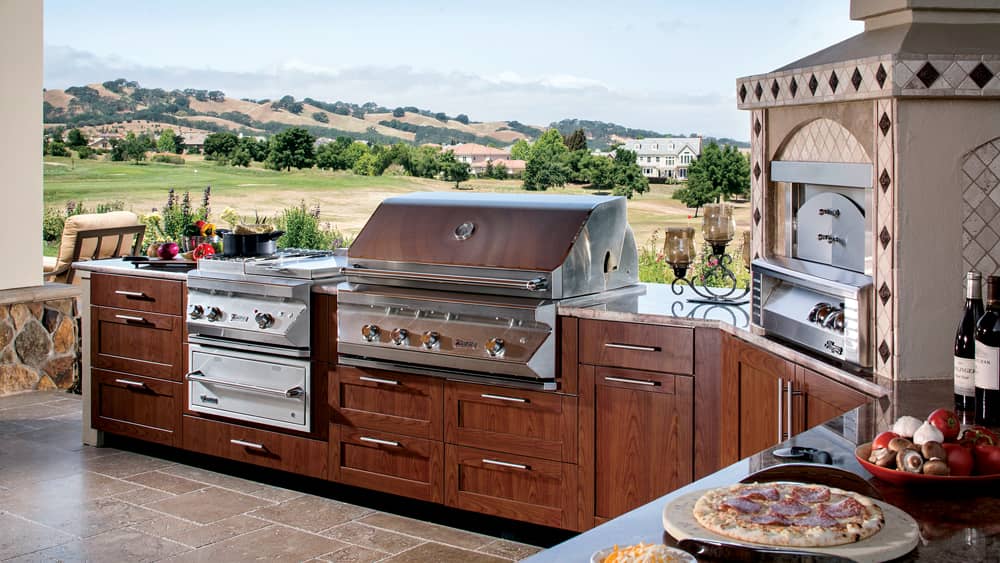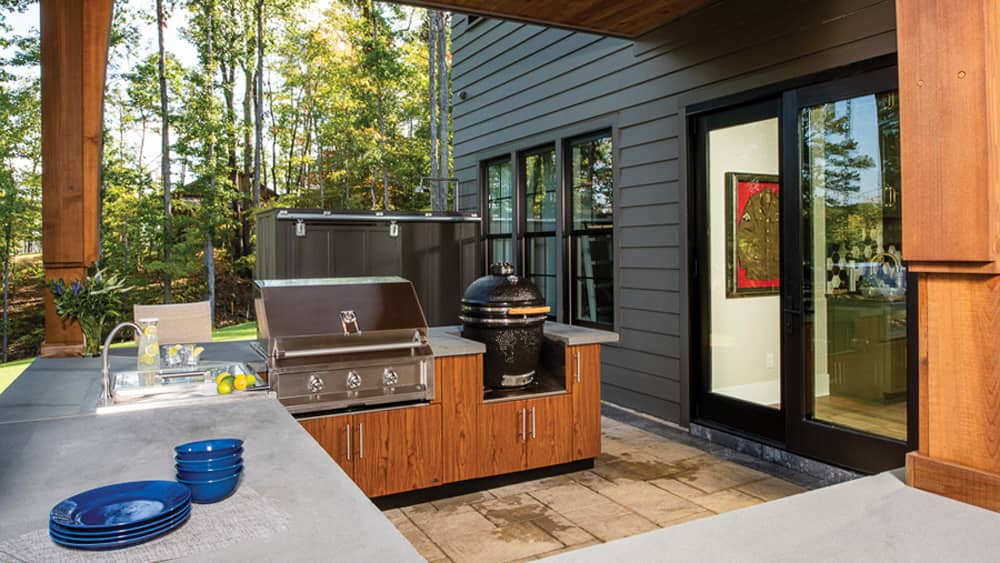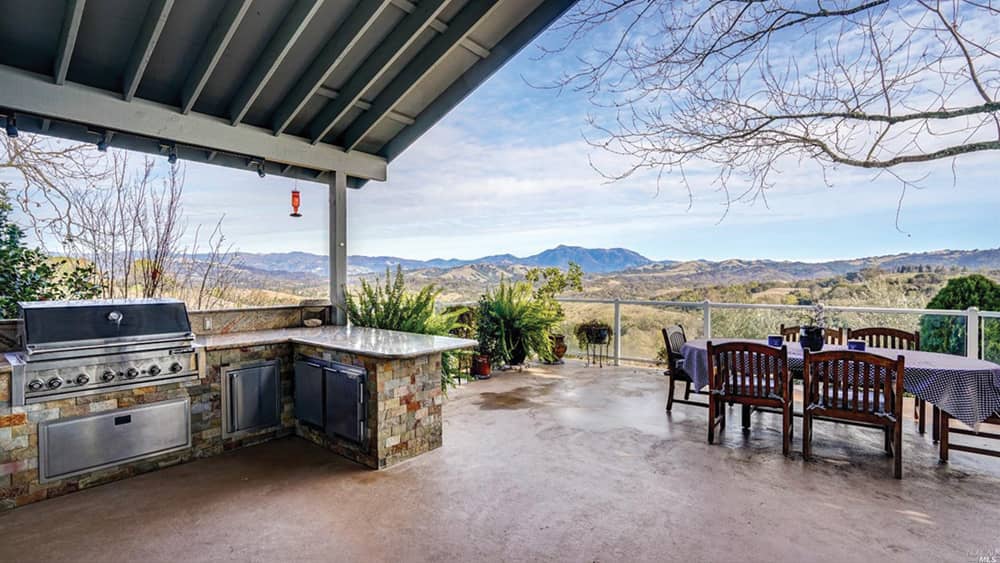
Many of us are content to cook in our backyards on a simple, kettle-style grill, and then enjoy flame-cooked hamburgers and hot dogs on a nearby patio. We don’t know what we’re missing. Wishing for, planning and building outdoor kitchens has increased in the North Bay during the past year, as the pandemic shutdowns that went on for months forced homeowners to take a hard look at how to improve their outdoor environments.
“My business has been on the uptick over the past year,” says Gary Torney, proprietor of Marin County-based Gary Torney Landscaping, a builder of outdoor kitchens. “And I foresee being just as busy in 2021. With the COVID crisis and people staying at home for months, they’ve created their own bubbles in their backyards for family and close friends. Many people who once traveled frequently––and then found themselves not traveling at all––decided to use that money to fix up their outdoor spaces. They started to see the possibilities of adding a kitchen and entertainment area for stay-cations.”

From a real estate perspective, an outdoor living space has the illusion of adding square footage because it’s an additional area that is enjoyed as an extension of a home, explains Karen Orlando, a Realtor with Luxe Places International Realty in Santa Rosa. “Sellers who installed outdoor kitchens usually get their investment in it back, and they may see even more of a return on their money if they sell the property in the summer months.”
“Homeowners increasingly regard their outdoor spaces as extensions of their homes, and therefore are building outdoor kitchens more elaborately, taking design elements and creature comforts into greater consideration,” says Bill Darcy, CEO of the National Kitchen and Bath Association. “Although more than one-third of outdoor kitchens are in warm-weather states (Florida, Texas and California), homeowners in northern states such as New York, Pennsylvania and Massachusetts are also making more use of their outdoor spaces for two or even three seasons, with amenities such as fireplaces, fire pits and patio heaters where needed.”
Unlimited possibilities
Wayfair, an online retailer of home décor and improvement products, last year reportedly saw searches on its site for “outdoor kitchens and dining areas” rise by 130 percent, and searches for “outdoor bars” increase by 155 percent.
The 2019 American Institute of Architects (AIA) Home Design Trends Survey showed that outdoor kitchens are one of the most-wanted features in new architectural projects. “Thanks to today’s design trends and technological advancements, the lines between indoor and outdoor kitchens are blurring, and in some cases disappearing completely,” says Mitch Slater, the founder and CEO of Danver cabinets, a Connecticut-based manufacturer of outdoor kitchen components. “While it’s now possible to maintain the same aesthetic for indoor and outdoor kitchens, it’s crucial to choose durable, low-maintenance materials that will withstand exposure to rain, snow and the elements.
“Homeowners increasingly regard their outdoor spaces as extensions of their homes, and therefore are building outdoor kitchens more elaborately, taking design elements and creature comforts into greater consideration.” — Bill Darcy, CEO of the National Kitchen and Bath Association
“We’ve seen an increased demand for storage and cabinetry, as more homeowners seek spaces that can operate independently from the kitchen proper and have space to keep tools for meal prep and cooking on hand,” he adds. “In that same vein, there’s a growing interest in cabinetry solutions that can accommodate a range of kitchen appliances.”
Traditional barbecues and grills are just the beginning of an array of specialty appliances that may be incorporated into an outdoor kitchen, according to the AIA survey. These include pizza ovens (woodburning or gas powered), smokers, side burners, drawer-style refrigerators, kegerators and wine refrigerators. Other assorted accessories can increase the functionality and longevity of these outdoor spaces, such as heat lamps or built-in infrared heaters and pergolas for shade, as well as fans and misters for cooling.
It seems there are unlimited possibilities to equip and accessorize an outdoor kitchen and adjacent entertainment and living areas, curbed only by imagination and budget.
Torney says the mild North Bay weather we enjoy most of the year creates an ideal connection from inside the home to outside. “I find people really want to capitalize on that feature, because an outdoor kitchen adds a great asset to their property. Outdoor living spaces can be anything even beyond kitchens. I built a project in Napa, an all-seasons pavilion with a metal roof, which created a new outdoor living room for the homeowners. They love sitting in that pavilion in the evening, [and] firing up a propane heater when necessary.”
Designing and building
At On Fire in Santa Rosa, a dealer selling several lines of outdoor kitchen cabinets and accessories, interest from customers for these components is on the rise. In late February, sales associate Mike Story was juggling the planning of seven outdoor kitchen projects at once. “The floodgates are open,” he says. “We’ve started strong so far this year [selling outdoor kitchens], and February is usually the month when people are getting their ideas for summer together and starting to make inquiries. Interest in adding an outdoor kitchen and sprucing up the backyard and making a nice area for entertaining had been building steadily even prior to the pandemic, but last year it seemed as if people were diverting vacation money to invest in their homes.”

“We don’t provide countertop materials, so it’s up to the customer to work with their contractor or through a tile company for the type of countertop they desire,” says Story.
He says it’s difficult to estimate an average cost of an outdoor kitchen because there can be so many variables in cabinet sizes, styles and the extras, such as appliances. “In general, a 10-foot Danver cabinet can cost from $13,000 to $19,000, grills can range from $2,000 to $6,500, and refrigerators from $2,000 to $3,900.”

Damon Gronlund of Sonoma County-based DG Construction has built and installed numerous outdoor kitchens, and is one of the contractors On Fire refers to its customers. “It’s always a good idea to talk to a contractor while ordering custom cabinets because many people don’t realize what city and county codes come into play and what they can and can’t do on their property,” he says. “Mike [Story], for instance, will go to the sites and look at the area where homeowners want to add the kitchen because he needs to know exact dimensions and possible code issues that can be resolved before ordering cabinets.”
However, Gronlund says he rarely runs into any complications acquiring the necessary permits for outdoor kitchens. “Sometimes, a homeowner will want to put a kitchen too close to their property line, and recently for that reason we had to set back a kitchen several feet away for it to be approved. But those kinds of things are not usually a problem. That’s why it’s necessary for me to go see the proposed location before I even submit a bid, in case there are unforeseen complications.”
If the homeowner wants to place an outdoor kitchen under any combustible materials, sufficient overhead clearance must be created so there is no risk of fire. Generally, fans and vents can be installed to exhaust heat away from any materials that could be flammable. “The last outdoor kitchen I built had the sink, refrigerator and ice drawer components right up against the exterior of the house. Those are not flammable, so no venting was needed,” he says.
Choosing wisely
Contractors also determine what’s needed to extend gas and electric lines to the site, and also a water line if a sink will be installed, and they can acquire all the necessary permits before the project begins. “Getting utilities to the site can sometimes be costly, depending on where the kitchen will be located on the property,” adds Torney. “For instance, it might require putting in an injection pump to get to the main sewer line. There can also be hidden costs that you have to factor in, and those will drive up the expense.
“It’s very easy to spend more than $50,000 to make the outdoor kitchen of your dreams–– sometimes the grills alone can cost up to $10,000,” he says.

Cabinets made of wood are strongly discouraged because they don’t hold up to weather, and can also be compromised by rodents. “A mouse can get into a space the size of your pinky finger, and they can burrow into wood and start nesting because they are attracted to the heat and dryness,” says Torney. To help keep nocturnal critters away from an outdoor kitchen before night falls, it’s imperative to bring indoors any soiled cooking tools, linens, dishes or other items still scented with food.
“It’s very easy to spend more than $50,000 to make the outdoor kitchen of your dreams–– sometimes the grills alone can cost up to $10,000.” — Gary Torney, proprietor, Gary Torney Landscaping
Metal and concrete cabinets are the smartest picks, but customers still must choose wisely. One important consideration, says Story, is how sunlight will reflect off metal cabinets. “If they want to install unprotected stainless steel, and it won’t be under a shaded area, it can be very bright and annoying.”
Real marble countertops will stain, and granite has to be sealed every couple of years. Natural stone also tends to crack from temperature extremes. So Gronlund recommends manmade or “engineered” stone that holds up well in outdoor situations, resists stains and is generally low maintenance, such as porcelain, recycled glass, concrete and quartz.
“You want to have an outdoor kitchen with easy surfaces to maintain, and which are easy to clean. And cleaning up around the grill when you’re finished cooking is very important,” adds Story.
Torney has seen some outdoor kitchens that he calls a bit “over the top,” incorporating entertainment areas with televisions and music systems. “I guess it’s for people who want to watch ballgames while they’re outside grilling. But really, most of my clients just want a nice place to grill burgers and hot dogs and to keep it simple. They want some seating, too, where they can look out at their friends and family and have conversations.”
Stunning focal points
When listing a property with an outdoor kitchen, Realtor Orlando mentions the features and uses photos that emphasize a backyard-living experience. She credits in part the many popular cooking shows on television for the robust popularity of outdoor kitchens. “I’ve seen all types of them in the North Bay, from simple to stunning, and they are quite the focal point,” she says. “Some are elaborate, with coverings such as arbors or ceilings, and have high-end appliances and materials.”
“Sometimes an outdoor kitchen isn’t on a prospective buyer’s list of must-haves, but many change their minds quite quickly when they see one. A few weeks ago, I was showing a house with an outdoor kitchen, and the clients said they immediately felt comfortable in that setting and could see themselves living in that house. When there is something so visually appealing to them, buyers are inclined to use that as a tipping point if they are considering other properties.”
Orlando says that while showing properties to prospective buyers, she’s never had a negative reaction to the presence of an outdoor kitchen. The same can’t be said for hot tubs. “I do get negative reactions to the tubs, especially when they look old and worn.”
We’ve all be sheltering in place for so long that outdoor kitchens represent a new dimension in entertaining, and is one of the best ways to welcome close friends and family members into our homes in a safe manner. The good news is, there are many resources in the North Bay to help homeowners design and build the outdoor living space that works best for them.
Basic Considerations
According to HomeAdvisor, an online marketplace for consumers to compare qualifications of local home services professionals, the planning and building of an outdoor kitchen is not a do-it-yourself project. There are numerous factors to consider and most should be handled by a pro, such as building structures to code, obtaining necessary permits, and running electrical and gas lines to the chosen location.
Outdoor kitchens can be designed and built for all budgets, giving homeowners a space to entertain friends and family. When planning an outdoor kitchen, here are a few basics to keep in mind:
Location. Find the sweet spot in your backyard that’s not too far from the house, but also not too close. You don’t want visitors to have to make a long walk back and forth to the area, and the grill shouldn’t be installed where smoke could create a hazardous situation, drift into your house, or be unpleasant for your seated guests.
Flooring. Materials such as tile or marble can become slick when wet. Other materials may not resist stains. And make certain the flooring you choose will hold the weight of the appliances you are installing.
Comfort features. Consider adding features that will keep everyone comfortable regardless of the weather. Heat lamps and a fire pit can warm up a chilly day, and misters and overhead fans can help keep visitors cool when the temperature soars. A roof or pergola can keep out moisture, while netting around the eating area will discourage insects.
Alfresco Living
In a 2019 survey of 303 homeowners, the National Kitchen and Bath Association (NKBA) revealed that 64 percent consulted with a design professional to plan their outdoor kitchens, and nearly all (84 percent) used or intended to hire professional installers for parts or most of their projects.
Alfresco cooking, dining and entertaining options are limitless, and the costs can start in the low five figures and rapidly increase. Outdoor living spaces, the NKBA said, “have evolved far beyond a grill on the patio and a picnic table. They frequently include hardscaping to define areas for eating, cooking and relaxing; built-in refrigerators, grills, sinks, storage and cabinetry; plumbing and drainage; bar areas with tap systems; shelter/overhead structures, and lighting/atmosphere controls.”
The NKBA report showed that the average spend on an outdoor kitchen is approximately $13,000. At least 22 percent of homeowners surveyed who built high-end outdoor kitchens spent more than $30,000; 14 percent spent between $20,000 and $30,000.
The survey also calculated what homeowners wish they had done differently when designing their outdoor spaces: build better structures for shade and protection from inclement weather (12 percent), make it a bigger space (10 percent), include more counter space (9 percent), enhance atmosphere/lighting/temperature controls (7 percent), and add more cabinets and storage space (5 percent).
Author
-

Jean Doppenberg is a lifelong journalist and the author of three guidebooks to Wine Country.
View all posts



